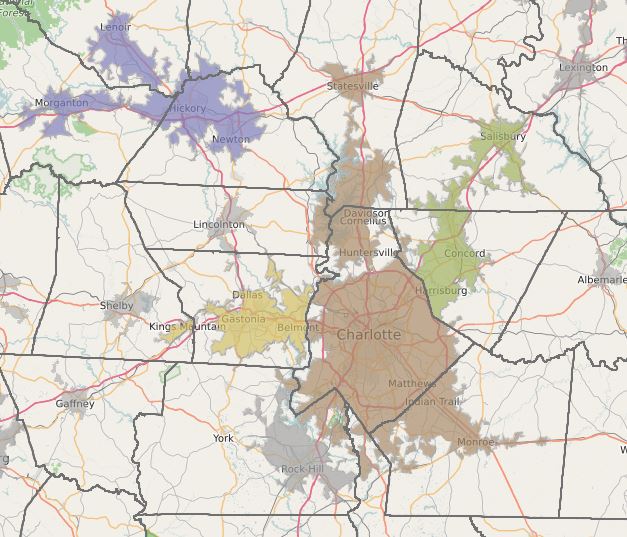Feds want metro transportation planning less fractured. Good luck with that.

What, exactly, is Charlotte’s metro region, and how cohesive is that region’s transportation planning?
Those questions have bedeviled planners for decades. Now, a new proposal from the U.S. Department of Transportation aims to make urban regions’ transportation planning more cohesive, a proposal possibly stemming from Transportation Secretary Anthony Foxx’s frustrations as Charlotte mayor. But will it make a difference in the fractured landscape of Charlotte region transportation planning? For now, the answer appears to be no.
To understand why this is even an issue, it helps to know some background – and to have a high tolerance for acronyms.
For starters, there are multiple, conflicting ways to define what a “metro region” is. Layered on top of political jurisdiction lines like city limits and county and state borders, you have a hodge-podge of other lines showing various ways that various governments look at metro regions. Different departments of state and federal government define “region” differently.
For regional transportation planning, the Charlotte area is particularly fragmented. The federal government divides urban areas into Metropolitan Planning Organizations or MPOs, which have significant roles to play in how federal and state transportation money is spent. (Meanwhile, the N.C. Department of Transportation has 14 different highway divisions that seemingly ignore MPO lines. And for now we won’t address the existence of RPOs, or Rural Planning Organizations.)
The way MPOs are organized, the metro region surrounding Charlotte is split among four MPOs – or five if you count Catawba County which sits on the western shore of Lake Norman. Catawba is part of yet another MPO.
Click map for larger view. Charlotte-area MPO is in brown, Cabarrus green, Gaston in yellow, York in gray and Catawba County in purple.
That means that however much people may travel from surrounding counties into Charlotte, the transportation planning for Mecklenburg County is being done by a separate entity from neighboring counties of Gaston, Cabarrus and, in South Carolina, York and Lancaster counties. Gaston, Cabarrus-Rowan, and York counties each have separate MPOs, named GCLMPO, CRMPO and RFATS. Charlotte’s MPO – formerly named MUMPO and now named CRTPO – takes in 27 jurisdictions in Mecklenburg, Union and Iredell counties.
It also means that a holistic balancing of regional priorities has a tough time taking place.
The practical result of this is, to take one example, that any cross-county transit planning anyone might want to undertake has a higher hurdle, since the Charlotte MPO isn’t the same as those in neighboring counties to the northeast (where the Blue Line Extension light rail was once planned to extend), the south (where the original Blue Line was once planned to extend) and the west – where regional commuter rail once ran from uptown Charlotte through Mount Holly and Belmont to Gastonia and where some dreamers hope it could exist again.
In late June, the Federal Highway Administration and Federal Transit Administration released a proposal to change federal rules governing how MPOs cooperate. (Read it here.)
“The rule was issued with little advance warning,” reported Alexander Bond, director of the Center for Transportation Leadership in a July article, “but USDOT Secretary Anthony Foxx has made no secret of his desire to see MPO consolidation. The fractured MPO landscape proved to be a problem during his service as mayor of Charlotte, N.C.”
According to Bond, the proposed rule changes would accomplish several policy objectives, including this: “One MPO Per Urban Area. The rule clarifies that one MPO per metropolitan planning area (a legal term that includes the Census-defined urban area plus land expected to be urban within 20 years) is the intent of statute and administrative code. Governors and local governments would be required to redesignate new MPOs with boundaries that meet the one-MPO-per-urban area standard. After each Census, MPOs would go through a similar process. … Urban areas that cross state boundaries are not exempt from the one MPO guideline.”
But there is a fly in that ointment, at least for the Charlotte area. MPOs are set up based on what are called Census-defined urban areas. The way the Census defines an urban area (if you want to go deep in the weeds click here and here) means “urban areas” for Gaston, Cabarrus, York and Mecklenburg counties are separate. Crazy? Some might think so.
The proposed rule would not require MPOs to consolidate, according to Robert Cook, the City of Charlotte transportation planner who serves as secretary to the CRTPO. And even if it did, by linking an MPO’s area to the “urbanized area” means in the Charlotte region they’d all remain separate anyway.
[highlight]“It’s time to rethink things.” — Robert Cook, secretary to Charlotte region MPO[/highlight]
He says the region’s other MPOs have made clear that full consolidation is off the table. He also notes that the four MPOs spend time, generally at staff level, making sure their actions don’t conflict with each other.
Cook predicts some boundary adjustments with surrounding MPOs, and if the proposed rules go into effect, the CRTPO will have to develop a joint long-range plan and Transportation Improvement Plan (a.k.a. TIP, which is updated every two years) with the Gaston and York County MPOs.
Cook can’t understand why the whole MPO set-up uses the Census-defined urban areas to create boundaries. “It probably made sense 40 years ago to use them, but it’s time to rethink things,” he said in an email interview.
Members of the CRTPO submitted comments on the proposed regulations, as part of the federal rule-making process. (Interesting side note: The comments were submitted to Gregory Nadeau of the FHWA and to Carolyn Flowers, former CEO of the Charlotte Area Transit System who’s now acting administrator of the FTA.) The No. 3 item of the 13 suggestions: “Consider using Metropolitan Statistical Areas (MSA) as the basis for defining metropolitan planning areas and establishing MPO boundaries.” (Read the letter with comments here.)
MSAs are much larger territories. For instance, the Charlotte-Concord-Gastonia-N.C.-S.C. MSA takes in 10 counties in North and South Carolina.
Most of the other 12 comments suggest changes to ease back on the idea of a joint long-range plan, to delay implementation of the rule changes, or to ensure that every jurisdiction that today has a seat at the table of smaller MPOs would keep a seat at the table.
For now, it appears transportation planning for the growing Charlotte region will remain splintered.
